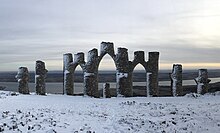
Muck is the smallest of four main islands in the Small Isles, part of the Inner Hebrides of Scotland. Today, much of the island is used for grazing. Residents use wool to make rugs and clothing. There are several ancient monuments and some facilities for visitors. The few residents are served by a single school, Muck Primary School & Nursery. The island is owned by the MacEwen family.

General Sir Hector Munro, 8th Laird of Novar, KB was a Scottish army officer and politician who served as the ninth Commander-in-Chief of Bengal from 1764 to 1765.
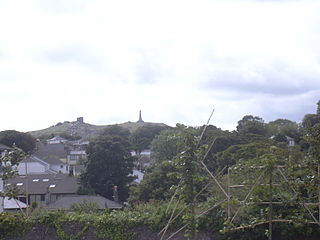
Carn Brea is a civil parish and hilltop site in Cornwall, England, United Kingdom. The population of Carn Brea including Bosleake and Church Coombe was 8,013 at the 2011 census. The hilltop site is situated approximately one mile (1.6 km) southwest of Redruth. The settlements of Bosleake, Brea, Broad Lane, Carn Arthen, Carn Brea Village, Carnkie, Four Lanes, Grillis, Illogan Highway, Pencoys, Penhallick, Piece, Pool, Tolskithy, Tregajorran, Treskillard, Tuckingmill and West Tolgus are in the parish.

Cairn Gorm is a mountain in the Scottish Highlands. It is part of the Cairngorms range and wider Grampian Mountains. With a summit elevation of 1,244.8 m (4,084 ft) above sea level, Cairn Gorm is classed as a Munro and is the sixth-highest mountain in the British Isles. The high, broad domed summit overlooking Strathspey is one of the most readily identifiable mountains from the nearby town and regional centre of Aviemore. Although it shares its name with the Cairngorm mountains, Ben Macdui is the highest mountain in the range.
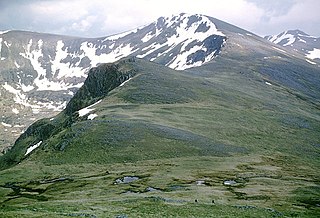
Carn Eighe is a mountain in the Northwest Highlands of Scotland. Rising to 1,183 metres (3,881 ft) above sea level, it is the highest mountain in Scotland north of the Great Glen, the twelfth-highest in the British Isles, and, in terms of relative height, it is the second-tallest mountain in the British Isles after Ben Nevis. Carn Eighe lies between Glen Affric and Loch Mullardoch, and is at the heart of a massif along with its twin peak, the 1,181-metre (3,875 ft) Mam Sodhail.

Alness is a town and civil parish in Ross and Cromarty, Scotland. It lies near the mouth of the River Averon, near the Cromarty Firth, with the town of Invergordon 3 miles (5 km) to the east, and the village of Evanton 4 miles (6 km) to the south-west. The parish has a population of 5,310, although the census locality, which includes part of the parish of Rosskeen, has a population of 5,186.

The Glasgow Necropolis is a Victorian cemetery in Glasgow, Scotland. It is on a low but very prominent hill to the east of Glasgow Cathedral. Fifty thousand individuals have been buried here. Typical for the period, only a small percentage are named on monuments and not every grave has a stone. Approximately 3,500 monuments exist here.
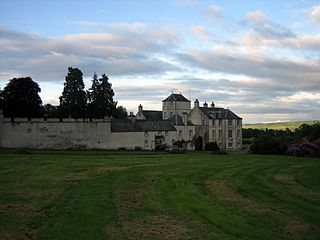
Foulis Castle is situated two miles south-west of Evanton in the parish of Kiltearn, Ross and Cromarty, Scotland. It is a white washed mansion that incorporates an old tower house with gun loops. The castle was held by the Clan Munro from the twelfth century or earlier and they had a stronghold there.

Sgurr na Lapaich is a mountain in the Northwest Highlands of Scotland, situated north of Loch Mullardoch in the high ground that separates Glen Cannich and Glen Strathfarrar. The mountain reaches a height of 1,150 metres, and is the fourth-highest mountain north of the Great Glen. There is no higher ground to the north of it in Great Britain.

The Monro of Fyrish family were a Scottish family and branch of the ancient highland Clan Munro. The family produced a notable dynasty of doctors to London in the 18th and 19th century where they were involved in early work on curing 'insanity'. Four generations occupied successively the position of (Principal) Physician of the notorious Bethlem Hospital (Bedlam). They were also leading members of a variety of important medical associations. Other members were painters, priests and philanthropists of note and one was an important early patron to J. M. W. Turner.

Novar House is an 18th-century building, located 0.7 miles north of the village of Evanton in Ross, Scotland. It is built on the site of an earlier castle.

Fyrish is the name given to an ancient area of land found just north of Evanton, Ross-shire, Scotland.
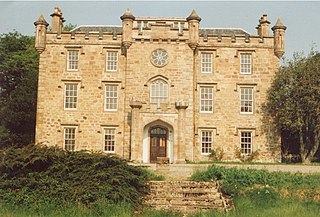
Teaninich Castle is situated north of the village of Evanton and just south of the town of Alness in Ross and Cromarty, Scotland.

Fetterangus is a small village in Aberdeenshire, Scotland, located just to the north of Mintlaw. Fetterangus is often called "Fishie", though the origin of this nickname is unknown.
Contullich Castle was a castle located a few miles north-west of the town of Alness, on the eastern side of the county of Ross-shire, Scotland.

The siege of Negapatam was the first major offensive military action on the Indian subcontinent following the arrival of news that war had been declared between Great Britain and the Dutch Republic, beginning the Fourth Anglo-Dutch War. A British force besieged the Dutch-controlled port of Negapatam, the capital of Dutch Coromandel, on the eastern coast of India, which capitulated after the fortification's walls were breached. The Dutch garrison consisted of 500 European troops, 5,500 local troops, and 2,000 troops of Hyder Ali, the ruler of Mysore.
Hector Munro, 13th Baron of Foulis was a Scottish clan chief of the highland Clan Munro in Rosshire. He is by tradition 13th Baron of Foulis and 16th overall chief of the clan. However, he is only the 6th chief of the Clan Munro who can be proved by contemporary evidence.

Clan Munro is a Highland Scottish clan. Historically the clan was based in Easter Ross in the Scottish Highlands. Traditional origins of the clan give its founder as Donald Munro who came from the north of Ireland and settled in Scotland in the eleventh century, though its true founder may have lived much later. It is also a strong tradition that the Munro chiefs supported Robert the Bruce during the Wars of Scottish Independence. The first proven clan chief on record however is Robert de Munro who died in 1369; his father is mentioned but not named in a number of charters. The clan chiefs originally held land principally at Findon on the Black Isle but exchanged it in 1350 for Estirfowlys. Robert's son Hugh who died in 1425 was the first of the family to be styled "of Foulis", despite which clan genealogies describe him as 9th baron.
